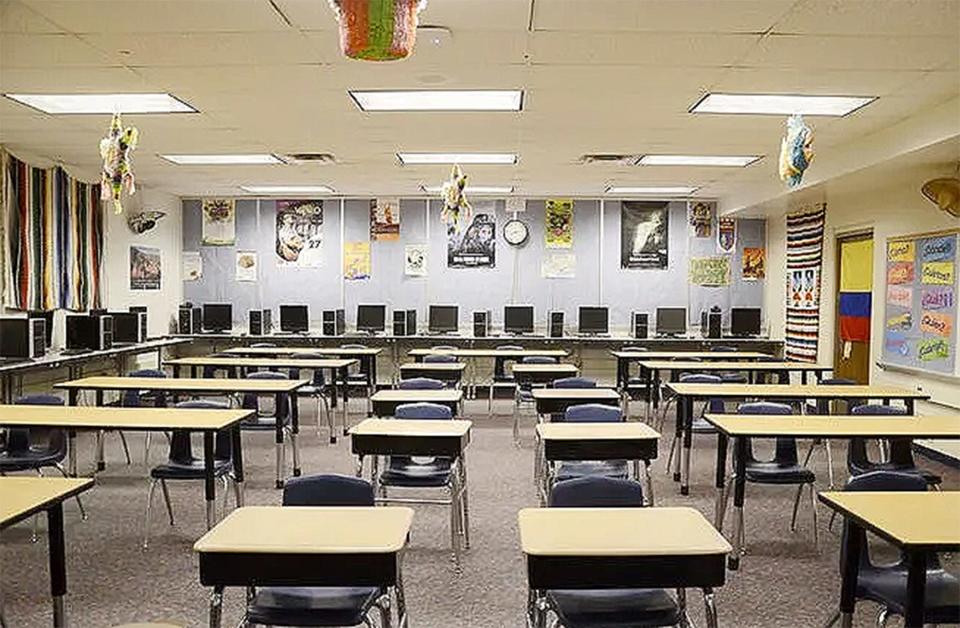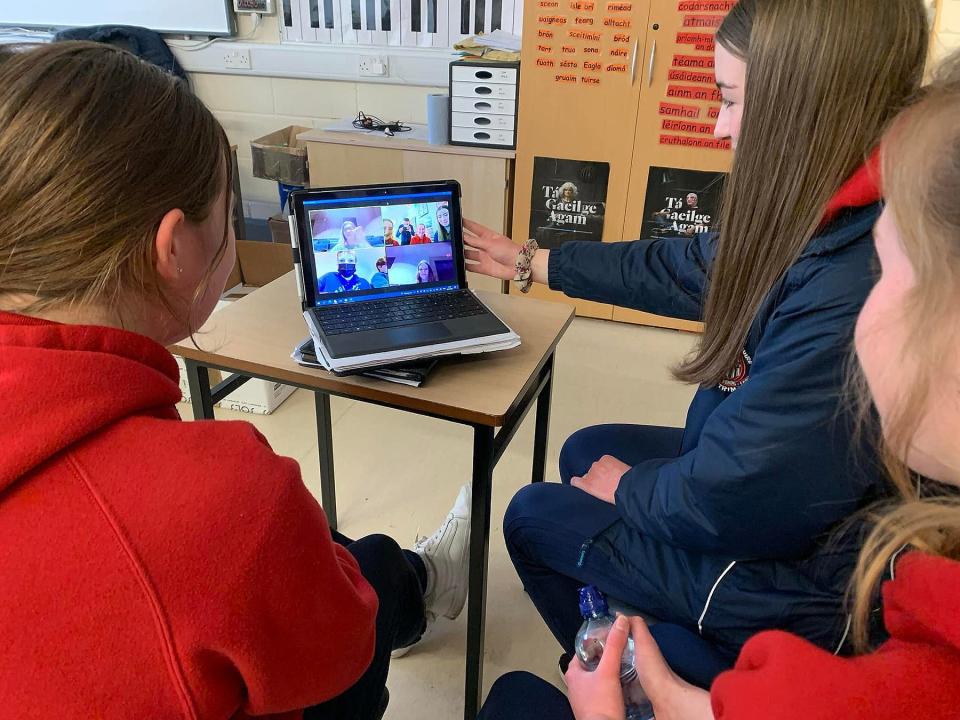The pandemic brought a technological revolution to schools. Is that a good thing?
Forced closures and quarantines at the height of the COVID-19 pandemic forced schools to ramp-up their efforts in one particular department: technology.
School districts that already had 1:1 initiatives — where each student is given a device, like a Chromebook or an iPad — were able to make the transition to remote learning easily. Other districts, often in rural areas, struggled to connect students with reliable internet access.
More:Efforts, funding aim to bring high-speed internet to every Michigander
Districts tried different ways of creating virtual classrooms — through Zoom or Google — seeking what worked best for teachers, students and parents.
Regardless of the path, by necessity, most educators agree the pandemic electrified the use of technology in the classroom.
“Absolutely,” said Becky Smith, director of teaching and learning for the Public Schools of Petoskey. “We had no choice but to go virtual."

For Petoskey, the largest district in Emmet County, the biggest change to come out of the pandemic is a new learning management system, a software application used across the whole district.
“The learning management system we use is Schoology, and that just made a consistent platform K-12 where all the information was posted, parents knew exactly where (to check assignments) and so on," Smith said.
Stephen Seelye, superintendent of Pellston Public Schools, said the pandemic “certainly did (speed things up)."
Fortunately for Pellston, a smaller district in northern Emmet County, the passage of the district’s first-ever sinking fund in March 2020 provided the funds needed to make adjustments quickly.
“We’re so fortunate to be able to have the money to purchase the needs that we had technology-wise to educate our students,” Seelye said. “It was a very big deal for us.”
Pellston was able to implement a 1:1 initiative and provide iPads to elementary students and Chromebooks to older students.
“I think even greater advances ... were the ability for teachers to reach students remotely,” Seelye said. “We were forced into doing that and it wasn’t a comfortable situation. Teachers were heroes in their ability to still make education happen through a huge array of technology sources.
"They had to reach kids in their bedrooms and on their couches and at their kitchen tables versus having them sitting in front of them for seven hours a day and they did it miraculously.”

What happens now?
In an increasingly online world, many educators plan to continue with technologies that proved successful during the pandemic.
“We still are going to use virtual parent-teacher conferences,” said Boyne City Superintendent Pat Little. “We did last week actually — and the reason for that, even though we could have gone back to in-person, is that we actually have a higher participation rate when we do it through Google Meet.”
In Boyne City, parent engagement is a strong focus.
"They didn’t have to get a babysitter, they didn’t have to take time off work, they could do it on their break or while they’re driving, and it’s a pretty focused conversation when it’s online because it’s only about 15 minutes,” Little said. “That’s probably one of the most positive (unintentional outcomes of COVID) that I’d say has happened.”
Boyne City plans to continue offering online classes.
“We do have more kids taking online classes," Little said. "We had that prior to the pandemic but we probably have more. I’d say kids are more comfortable with online learning than they were before the pandemic. I think everybody tried it, and them some kids were like, ‘You know, this isn’t too bad.’”
At the district’s alternative Morgan-Shaw School, enrollment jumped from 29 to 44 this year.
“The online world, for some of our kids who are looking at an alternative setting, is working for them,” Little said. “It’s a different way to get your education but it’s still meeting all the requirements.”
Educators said technology allows teachers to further individualize instruction for students.
“It increased our ability to meet the needs of kids at a high, middle and low achieving level and try and catch everybody up to speed,” Seelye said. “The pandemic greatly increased that.
"We’ve always had students at different levels, but the pandemic made that even farther separated, because some students had to stay home for remote learning and some returned to school and some were quarantined more than others, so I think the biggest speed up was that ability to meet students at their level through technology.”
Is newer better?
While many hail the benefits of boosted technology, some educators lament the loss of a teacher’s personal touch.
Don Hicks taught for three decades at Bronson Community Schools in Branch County before retiring in December 2020. He's concerned online interaction between students and teachers stifles learning.
He used percentages to describe learning levels at Bronson, which used Chromebooks with some computerized instruction before COVID-19 pushed all classes online.
"The general consensus was they were learning at about 30 percent (at the beginning of the pandemic)," Hicks said. "We lost about 70 percent. That was in early 2020."
He believes today, after improvements in curriculum and interactivity, student learning might be up to 50 or 60 percent.
“I just don't think it's as good as if you have a solid teacher,” he said.
Dave Mathis taught social studies and government at Union City High School for 35 years until he retired in 2005. He later returned to substitute teaching at Coldwater High School.
Mathis said his classes have Chromebooks, but he misses the days when students interacted with each other, rather than with computers. He turned classrooms into legislatures and courtrooms.
Coldwater Community Schools Superintendent Terry Whelan said computers make teaching more efficient and give students greater opportunities for learning.
“They have Google Classroom where they can go and get all their assignments and search," he said. "But that doesn't take away from the teacher teaching."
Pellston superintendent Seelye said they're trying to find that “perfect balance.”
“We were sped up into the use of technology, but I was just in my fourth grade classroom and those students were working on their cursive handwriting,” he said. “We want to make sure that we balance ... not go away from the tried and true things that are important to students.
"They still need to know how to take notes by hand, they still need to have good penmanship and be able to sign their names in cursive … They still need to know what it feels like to check a book out of one of our libraries and turn the pages on it versus reading everything through a screen.”
What does the future hold?
What does the future of classroom instruction look like? Certainly technology filled, with some students learning to code, fly drones and create robots.
“We’re working hard to improve our STEM advancements,” Seelye said. “We’ve got mini-robots in our elementary school … we’ve got a high school robotics team and program."
Little in Boyne City wants to see advances in virtual reality reach the classroom. The district invested in two sets of VR equipment in 2017, but he envisions breakthroughs that will allow students to go on a field trip to places like the Colosseum in Rome without ever leaving their desks.
“I think it could bring a lot to the classroom," he said.
Smith in Petoskey said people will see more “project-based classrooms” with a hybrid of technology and teaching.
“(It will be) very intentional where students are utilizing technology more on an individualized or small group basis, so that you can really target where those students are with their learning,” she said.
Subscribe:Check out our offers and read the local news that matters to you
Mathis said using technology in the classroom is inevitable.
“We live in a technologically driven world,” Mathis said. “I'd like to see a balance between a teacher that's providing information and a framework for debate. I just think you can really have a rich classroom that is largely absent of the Chromebooks.”
— Contact Jillian Fellows jfellows@petoskeynews.com and Don Reid at dreid@thedailyreporter.com.
This article originally appeared on The Petoskey News-Review: The pandemic brought a technological revolution to schools. Is that a good thing?

